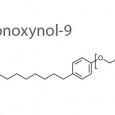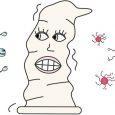We here are talking about an uncommon situation. Chances are slim that if you use condoms, you might catch chlamydia. Nevertheless, there is no method that provides 100% safety from STDs.
Though the chances are slim, nonetheless, there are some chances that one may get chlamydia infection even by using a condom.
Chlamydia is a unique organism
Before we answer the main question, let us see what chlamydia is. These are really unique organisms. Once, researchers thought that they were viruses, but now they are classified as bacteria. So, in fact, they are something in-between the bacteria and viruses.
They are now regarded as bacterium since they have RNA, DNA, and a cell wall. Nonetheless, they display some properties of the virus. They are immobile outside the living cells. They need to enter the living cells to become active and start multiplying – quite like viruses. [1]
So, yes, they are very unique. These tiny organisms are known to cause some health issues like eye infections, genital infections, and respiratory issues. However, in many people, they cause very mild illnesses and may even remain undetected for a long.
In some people, they might not cause any signs and symptoms for years. Therefore, in many cases, chlamydial infection is diagnosed just by chance. However, in other instances, they might become more active, causing health issues during periods or a decline in immunity. It means that it is very difficult to say when did chlamydia initially infect one.
Chlamydia and STDs
Though there are many types of chlamydia, sexually transmitted diseases (STDs) are caused by Chlamydia trachomatis. It can cause a severe infection of the genitals. In women, it might cause chronic issues like pelvic inflammatory disease, infertility, ectopic pregnancy, chronic pelvic pain, etc.
Chlamydia is pretty common, and researchers estimate that there are more than four million people living with the infection in the US alone. [2]
However, it is also worth understanding that the majority of adults living with chlamydia are just carriers of the infection, and they do not show any symptoms. Chlamydia mainly affects sexually active young adults between the age of 15 to 24 years.
Since chlamydia is not active in the environment, it mainly spreads in humans through the exchange of body fluids, mainly through sexual activity.
It is vital to understand that the majority of the cases are of so-called “silent infection.” This means that chlamydia does not cause many symptoms in the majority of cases. Studies suggest that just about 10% of men ever develop its symptoms. Similarly, studies indicate that about 5-30% of women develop symptoms.
In men, it may cause urethritis or pain when peeing. In some cases, it may cause watery urethral discharge. In addition, in some men, it may cause epididymitis, thus causing testicular pain, swelling, and tenderness.
The Possibility of Contracting Chlamydia Despite Using a Condom
Since chlamydia does not cause much trouble in the majority of cases, it remains undetected. Nevertheless, it cannot cross the barriers like condoms.
Thus, theoretically, condoms are quite suitable for preventing chlamydia. It would be correct to say that condoms can prevent chlamydia infection in 90% of the cases, but not 100%, as some body fluid exchange occurs during sexual activity.
Even when wearing condoms, a person may still come in contact with the partner’s body fluids.
Factors that Increase the Risk of Contracting Chlamydia
Though condoms are quite good at protecting from chlamydia, bear in mind that they cannot protect in all cases. In addition, certain factors may increase the risk of chlamydia, like condom breakage occurring too frequently, slipping off the condoms, using wrong-sized condoms, and so on.
Similarly, many people may delay the use of condoms during sexual activity. For example, they might not use a condom during foreplay. Hence, they might still get chlamydia, even if they use condoms regularly.
Frequently Asked Questions
If I always use a condom, am I 100% safe from STIs?
Though always using condoms is highly recommended, it would not essentially confirm 100% protection. Nevertheless, using condoms is one of the best and most effective ways of preventing the spread of the infection.
Should I get tested for chlamydia if I do not have any signs and symptoms?
Yes, if you often have unprotected sex or multiple partners, there is a strong reason to be tested for chlamydia, even in the absence of any symptoms. Remember that in 90% of men, it does not produce any signs and symptoms.
However, in the long run, it may cause severe health issues.
After how much time can I develop symptoms of chlamydia?
This isn’t easy to predict. If you developed chlamydia symptoms, it does not mean that you contracted the infection recently. In many men, it may remain dormant for years before becoming active.
If a person has chlamydia, can condoms still be used as a form of protection?
If one has been diagnosed with chlamydia, then it is even more important to use condoms. Condoms will help prevent the spread of infection. In such cases, one needs to wear condoms to protect others.
Conclusion
It is vital to understand that using condoms is the most effective way known to science to prevent the spread of chlamydia and other sexually transmitted diseases. Of course, it may not be a perfect way or 100% effective.
But, with some knowledge, and extra precautions, it can be very close to 100% in preventing the spread of infections.
References
- Becker Y. Chlamydia. In: Baron S, ed. Medical Microbiology. 4th ed. University of Texas Medical Branch at Galveston; 1996. Accessed May 20, 2023. http://www.ncbi.nlm.nih.gov/books/NBK8091/
- Detailed STD Facts – Chlamydia. Published April 10, 2023. Accessed May 20, 2023. https://www.cdc.gov/std/chlamydia/stdfact-chlamydia-detailed.htm






 Dr. Preet Pal Singh Bhinder is a physician (M.D. Medicine) with a specialization in diabetes (Fellowship in diabetes, Royal Liverpool Academy). He is a lifetime
Dr. Preet Pal Singh Bhinder is a physician (M.D. Medicine) with a specialization in diabetes (Fellowship in diabetes, Royal Liverpool Academy). He is a lifetime
What was the name of the person that made this question about chlamydia being transferable even with a condom?